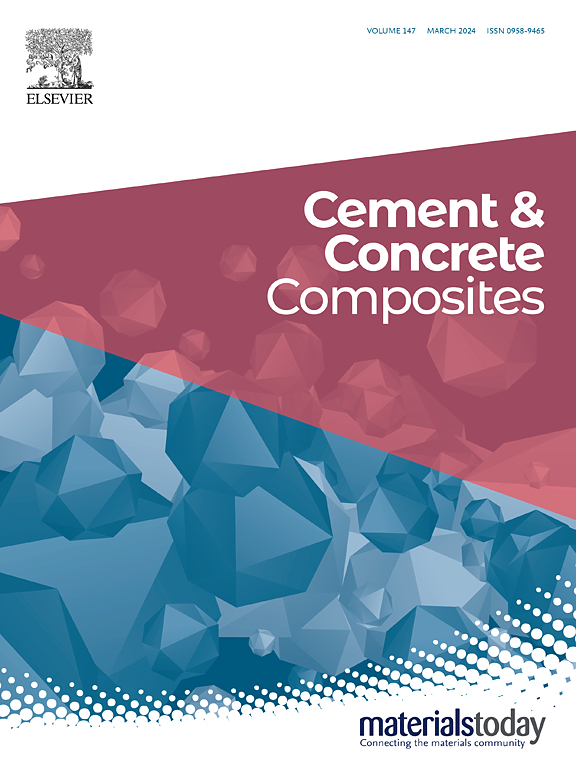Preliminary study on in-situ spore germination at different crack depths in bacteria-based self-healing concrete
IF 10.8
1区 工程技术
Q1 CONSTRUCTION & BUILDING TECHNOLOGY
引用次数: 0
Abstract
Bacteria-based self-healing concrete is promising in sustainable constructions, while the germination of carbonate precipitating bacterial spores in crack zone is the start of the healing process, and hence has great impact on crack healing efficiency. In this study, the Ca-alginate hydrogel sheets encapsulated spores were pre-embedded at specific crack depths, and the in-situ germination behavior of bacterial spores was monitored by an optical oxygen microprobe. The influence of crack depth and crack environment (pH and Ca2+) on spore germination was extensively examined. The results showed that the oxygen distribution within the crack was heterogeneous, with oxygen easily available at the crack mouth and difficult to diffuse in the deep part. The germination time of the spores at 1/3 and 2/3 crack depth was 1d and 2d, respectively. With two spores containing hydrogel sheets embedded at the same time, the spore germination at 2/3 crack depth was further delayed about 2d. The Ca2+ concentration was heterogeneous within the crack, increasing significantly from about 0 mM (surface) to 80 mM (40 mm deep), which had a limited influence on spore germination. The pH distribution was also heterogeneous. The pH value at the crack mouth was about 11 and increased to more than 12.5 at the crack deeper part, indicating that pH might be a controlling factor affecting spore germination at different crack regions. The uneven distribution of oxygen concentration and pH in the crack had a significant influence on the spore germination, and hence affect the healing efficiency at different crack depths.
细菌基自愈混凝土不同裂缝深度下原位孢子萌发的初步研究
细菌自愈混凝土在可持续建设中具有广阔的应用前景,而裂缝区碳酸盐沉淀细菌孢子的萌发是裂缝愈合过程的开始,因此对裂缝愈合效率有很大影响。在本研究中,将海藻酸钙水凝胶片包裹的孢子预先包埋在特定的裂纹深度,并通过光学氧探针监测细菌孢子的原位萌发行为。广泛研究了裂缝深度和裂缝环境(pH和Ca2+)对孢子萌发的影响。结果表明:裂纹内氧气分布不均匀,在裂纹口处氧气容易进入,而在裂纹深部氧气扩散困难;孢子在1/3和2/3裂缝深度的萌发时间分别为1d和2d。同时包埋两个含有水凝胶片的孢子,孢子在2/3裂缝深度的萌发时间进一步延迟约2d。裂缝内Ca2+浓度不均匀,从0 mM(表面)到80 mM (40 mM深)显著增加,对孢子萌发影响有限。pH分布也具有异质性。裂缝口处pH值约为11,裂缝较深处pH值增加至12.5以上,说明pH值可能是影响不同裂缝区域孢子萌发的控制因素。裂缝中氧浓度和pH分布的不均匀对孢子萌发有显著影响,从而影响不同裂缝深度的愈合效率。
本文章由计算机程序翻译,如有差异,请以英文原文为准。
求助全文
约1分钟内获得全文
求助全文
来源期刊

Cement & concrete composites
工程技术-材料科学:复合
CiteScore
18.70
自引率
11.40%
发文量
459
审稿时长
65 days
期刊介绍:
Cement & concrete composites focuses on advancements in cement-concrete composite technology and the production, use, and performance of cement-based construction materials. It covers a wide range of materials, including fiber-reinforced composites, polymer composites, ferrocement, and those incorporating special aggregates or waste materials. Major themes include microstructure, material properties, testing, durability, mechanics, modeling, design, fabrication, and practical applications. The journal welcomes papers on structural behavior, field studies, repair and maintenance, serviceability, and sustainability. It aims to enhance understanding, provide a platform for unconventional materials, promote low-cost energy-saving materials, and bridge the gap between materials science, engineering, and construction. Special issues on emerging topics are also published to encourage collaboration between materials scientists, engineers, designers, and fabricators.
 求助内容:
求助内容: 应助结果提醒方式:
应助结果提醒方式:


